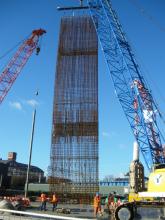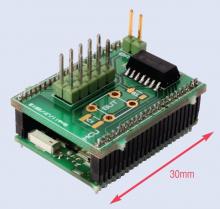Submitted by Administrator on Tue, 15/09/2015 - 11:11
The Government Office for Science publishes CSIC’s Head, Professor Robert Mair’s Thought Piece as part of its Foresight Future Cities project

Image: Transforming King's Cross Station area, London. Copyright BAM Design for the King's Cross Central Limited Partnership
The potential exists in the world’s cities for creating high quality infrastructure, vibrant communities, long term sustainability, and highly efficient transport systems – all reaching the highest aspirations of society. But unfortunately there is also serious potential for inadequate infrastructure, waste, pollution, inefficiency, desperate overcrowding and poverty, and social division.
If future cities are to be well-led and well-managed, they must have high-quality infrastructure, so that they can provide the best services, quality of life, economies and jobs. Important city infrastructure comprises such items as tunnels, bridges, roads, railways, buildings and utilities; its quality and performance is essential for supporting economic growth and productivity. High quality city infrastructure attracts globally-mobile businesses and promotes social well-being.
Modern city infrastructure must be robust, resilient and adaptable to changing patterns – particularly natural disasters and climate change. It also needs to be optimised in terms of efficiency, cost, low carbon footprint and service quality. It can benefit enormously from being ‘smart’, which involves the innovative use of emerging technologies in sensor and data management.
The Cambridge Centre for Smart Infrastructure and Construction (CSIC), funded by EPSRC, Innovate UK and industry, aims to transform the future of city infrastructure. Its role is to advance research in smart infrastructure and create impact in the infrastructure and construction industry. CSIC is developing cutting edge sensing and data analysis models. These will provide a powerful platform for providing data to enable smarter and proactive asset decisions, both during construction of new city assets and for existing city infrastructure.
CSIC is collaborating with industry to commercialise independent, world-leading research and drive technology-led business growth using novel technologies such as:
• fibre optics
• wireless sensor networks
• low power sensors based on micro electro mechanical systems (MEMS)
• computer vision
• energy harvesting
There are real opportunities for these new technologies to revolutionise the construction and management of city infrastructure, leading to considerably enhanced efficiencies, economies, resilience and adaptability. This could benefit not just the construction industry but also society served by its infrastructure.
Emerging technologies can also be applied to advanced health monitoring of existing critical infrastructure assets in cities to quantify and define the extent of ageing and the consequent remaining design life of infrastructure, thereby ensuring resilience and reducing the risk of failure. The latest sensor technologies can also transform the industry through a whole-life approach to achieving sustainability in construction and infrastructure in an integrated way - design and commissioning, the construction process, exploitation and use, and eventual de-commissioning.
The engineering, management, maintenance and upgrading of city infrastructure requires fresh thinking to minimise use of materials, energy and labour whilst still ensuring resilience. This can only be achieved by a full understanding of the performance of the infrastructure, both during its construction and throughout its design life, through the application of innovative sensor technologies and other emerging technologies.
There is a compelling case for using sensing and data analysis to enable smarter, proactive asset management decision-making for city infrastructure. Being proactive, not reactive, enables maintenance, inspection and refurbishment programmes for city infrastructure assets to be developed, focusing on condition and preventive maintenance. It is essential to capture and analyse the right data at the right time for city asset management decisions to be effective.
CSIC has recently been actively involved on more than 40 construction sites and existing infrastructure examples, almost all of them in cities, applying emerging technologies such as fibre optic sensors and wireless sensor networks.
Fibre Optic Sensors

Structural integration of fibre optic sensing systems represents a new branch of engineering and is a major breakthrough in creating smart city infrastructure. Fibre optic sensing is capable of being the nervous system of infrastructure. It involves the unique marriage of fibre optics, optoelectronics and composite material science. CSIC’s fibre optics technologies enable strain measurements in the tens of microstrain range in a continuous manner over lengths of up to 10 km; the fibre optic cable is in effect a long continuous strain gauge.
Figure 1: Installation of reinforcement cage for Crossrail diaphragm wall (for a deep shaft) with fibre optic sensors attached
Recent examples of CSIC’s successful application of fibre optic sensing to city infrastructure are:
• performance monitoring of deep shafts and retaining walls at Crossrail’s Pudding Mill Lane, Limmo, Stepney Green and Paddington Station sites
• monitoring of a very deep diaphragm wall (84m) at the Abbey Mills shaft for Thames Water
• assessment of National Grid’s tunnel lining behaviour during tunnel construction in London by embedding optical fibre in the precast concrete lining segments when being made in the factory
• monitoring of masonry arches at London Bridge Station to observe the movements during extensive piling work beneath
• field testing of thermal piles to evaluate the thermo-mechanical response of piles during heating and cooling for ground source heat pump systems, carried out at London’s Shell Centre, at a major new London embassy and at a site in Houston, USA with Virginia Tech and the US National Science Foundation
• field testing of large diameter piles by integrating fibre optic strain measurement with O-Cell loading test technology, for example for the new Francis Crick Institute in London
• monitoring of the 100 year old former Royal Mail Railway tunnel during construction of Crossrail’s Liverpool Street Station tunnels very close beneath
Working closely with the Knowledge Transfer Partnership (KTP) Associates (employed by Cambridge University and funded by both Crossrail and Innovate UK) CSIC has led the development and installation of fibre optic sensors on four Crossrail sites. The fibre optic sensors have been successfully installed on the diaphragm wall reinforcement cages at the sites, with the fibre optic cable being unrolled from drums and fixed to the cage at intervals as it is lowered into the deep trench in the ground, as shown in Figure 1. Robust installation techniques for achieving reliable measurements have been successfully developed. The data from the fibre optic sensors has provided completely new insights into the behaviour of the shaft linings and retaining walls during construction. The sensors will continue to provide data on the performance of these structures throughout their design life. This fibre optic sensing allows informed decision-making based on reliable evidence. Rationalisation of design approaches for shafts and retaining walls, based on actual observed performance, will be of direct economic benefit to city infrastructure, leading to more efficient designs, reduced amounts of material and faster construction.
Wireless Sensor Networks and Micro Electro Mechanical Systems
 Future smart sensor systems in city infrastructure will undoubtedly comprise Wireless Sensor Networks (WSN) as part of the “internet of things” and will be designed around the capabilities of autonomous nodes. Each node in the network will integrate specific sensing capabilities with communication, data processing and power supply; an example is shown in Figure 2.
Future smart sensor systems in city infrastructure will undoubtedly comprise Wireless Sensor Networks (WSN) as part of the “internet of things” and will be designed around the capabilities of autonomous nodes. Each node in the network will integrate specific sensing capabilities with communication, data processing and power supply; an example is shown in Figure 2.
Figure 2: Wireless sensor network mote
CSIC’s WSN system is fully integrated with sensors – many of these are based on MEMS technology. MEMS are small integrated devices or systems that combine electrical and mechanical components varying in size from micrometers to millimetres. These can merge the function of computation and communication with sensing and actuation to produce a system of miniature dimensions, which has huge potential for smart city infrastructure sensing in terms of low power requirements and low cost.
The major advantages of MEMS sensors over conventional monitoring systems are their:
• smaller size
• lower power consumption
• cheaper cost due to mass production
• extended performance and lifetime
It is possible to envisage integrated MEMS WSN systems offering a solution to monitor and control physical and chemical parameters in many smart city infrastructure applications.
CSIC’s recent R&D development in WSN includes open source WSN software and hardware for civil engineering monitoring, a network diagnostic tool and a ‘BIM friendly’ WSN planning and maintenance tool (‘BIM’ being Building Information Modelling). Examples of CSIC’s recent deployment of WSN in city infrastructure are:
• a large scale WSN system in the 100 year-old former Royal Mail Railway tunnel to measure its behaviour and movement during construction of a large diameter platform tunnel very close beneath it as part of Crossrail’s Liverpool Station project
• a WSN system at Crossrail’s Paddington Station site to monitor the movement of retaining walls during excavation
• a WSN system at London Underground’s Tottenham Court station to monitor the performance of timber based temporary underground work
• development and deployment of a miniature, ultra-low power “UtterBerry” WSN mote by CSIC PhD student Heba Bevan (see Figure 3)

Figure 3: Ultra-low power ‘UtterBerry’ wireless sensor mote (copyright UtterBerry)
The Future of Smart Cities
The challenges facing us are enormous and pressing: many cities are predominantly located on the coast, so how can we protect them from rises in sea levels? How will we provide infrastructure for future cities as resources become increasingly scarce and energy more expensive? What will future cities look like in the coming decades? Will car ownership disappear, with the likely arrival of autonomous vehicles? How will social behaviour change?
For our future cities our society needs urgently to address the needs for smart infrastructure, the most modern communications and information systems in our digital era, the provision of clean water, sanitation and healthcare – all vital for our social well-being.
Being in the midst of a digital revolution, we cannot underestimate the importance of big data. This also has a hugely important part to play in the design, development and management of our future smart cities. New sensor technologies such as those described earlier in this article are capable of producing vast amounts of new and important data to provide new understanding, streamlining and health monitoring of the nation’s city infrastructure. However, this data needs to be managed in an integrated way, and to this end CSIC is working closely with the British Standards Institute to develop and trial Smart City Standards. These standards will help to develop the market for smart city products and services and how these can be used to enable cities to become smarter.
Future challenges are to establish smart sensor methodologies for city infrastructure that are robust, work in heavily confined space conditions with intensive construction activities, ensuring that the system (both sensor and communication) is calibrated properly, and that the data is reported in a way that it can be used effectively to make informed decisions.
These innovative sensor technologies are vital ingredients to the future of city infrastructure. Our cities will define the future of society, and smart city infrastructure equipped with modern sensors is essential to achieve the required transformational impact.
- The Government Office for Science’s Foresight `Future Cities’ project looks at the opportunities and challenges facing UK cities over the next 50 years. It aims to develop the evidence base on the trends and influences most likely to shape the future of UK cities and commissions and publishes a series of working papers, essays and blogs written by leading experts as part of this.
- To read Professor Mair’s thought piece on the Government Office for Science website click here
- For more information about the Foresight Future Cities project click here
